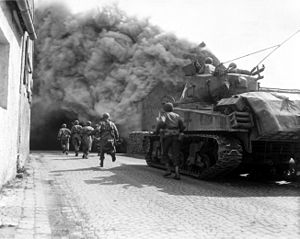
Western Allied invasion of Germany
1945 offensive in the European theatre of World War II / From Wikipedia, the free encyclopedia
Dear Wikiwand AI, let's keep it short by simply answering these key questions:
Can you list the top facts and stats about Western Allied invasion of Germany?
Summarize this article for a 10 years old
The Western Allied invasion of Germany was coordinated by the Western Allies during the final months of hostilities in the European theatre of World War II. In preparation for the Allied invasion of Germany east of the Rhine, a series of offensive operations were designed to seize and capture its east and west banks: Operation Veritable and Operation Grenade in February 1945, and Operation Lumberjack and Operation Undertone in March 1945; these are considered separate from the main invasion operation. The Allied invasion of Germany east of the Rhine started with the Western Allies crossing the river on 22 March 1945 before fanning out and overrunning all of western Germany from the Baltic in the north to the Alpine passes in the south, where they linked up with troops of the U.S. Fifth Army in Italy.[16][notes 1][17] Combined with the capture of Berchtesgaden, any hope of Nazi leadership continuing to wage war from a so-called "national redoubt" or escape through the Alps was crushed, shortly followed by unconditional German surrender on 8 May 1945. This is known as the Central Europe Campaign in United States military histories.
| Invasion of Germany (Western Allies) | |||||||||
|---|---|---|---|---|---|---|---|---|---|
| Part of the Western Front of the European theatre of World War II | |||||||||
 American infantrymen of the U.S. 11th Armored Division supported by an M4 Sherman tank move through a smoke filled street in Wernberg, Carinthia, April 1945. | |||||||||
| |||||||||
| Belligerents | |||||||||
|
| |||||||||
| Commanders and leaders | |||||||||
| Units involved | |||||||||
|
|
| ||||||||
| Strength | |||||||||
|
4,500,000 (91 divisions)[2][lower-alpha 1] 17,000 tanks[3][lower-alpha 2] 28,000 combat aircraft[5] 63,000 artillery pieces[lower-alpha 3][lower-alpha 2] 970,000 vehicles[5] |
Initial: 1,600,000 [6][7] About 90 tanks and 400 "other armored vehicles", assault guns, Stug III, etc.[8] 2,000 operational combat aircraft[9] | ||||||||
| Casualties and losses | |||||||||
|
American: 62,704 casualties[lower-alpha 4][10] Canadian: 6,490 casualties[lower-alpha 5][11] British: 17,930 casualties[12][lower-alpha 6][12] French: 18,306 casualties[13][lower-alpha 7] Other Allies: 715 casualties[12][lower-alpha 8] |
January–May 1945: | ||||||||
By early 1945, events favored the Allied forces in Europe. On the Western Front, the Allies had been fighting in Germany with campaigns against the Siegfried Line since the Battle of Aachen, the Battle of Metz and the Battle of Hürtgen Forest in late 1944 and by January 1945, had pushed the Germans back to their starting points during the Battle of the Bulge. The failure of this offensive exhausted Germany's strategic reserve, leaving it ill-prepared to resist the final Allied campaigns in Europe. Additional losses in the Rhineland further weakened the German Army, leaving shattered remnants of units to defend the east bank of the Rhine. On 7 March, the Allies seized the intact bridge across the Rhine at Remagen, and established a large bridgehead on the river's east bank. During Operation Lumberjack, Operation Plunder and Operation Undertone, German casualties during February–March 1945 are estimated at 400,000 men, including 280,000 men captured as prisoners of war.[18]
On the Eastern Front, the Soviet Red Army (including the Polish Armed Forces in the East under Soviet command), had taken most of Poland, launched an offensive into East Prussia and began their invasion into Eastern Germany in February 1945, and by March were within striking distance of Berlin. The initial advance into Romania, the First Jassy–Kishinev Offensive in April and May 1944 was a failure; the Second Jassy–Kishinev Offensive in August succeeded. The Red Army also pushed deep into Hungary (the Budapest Offensive) and eastern Czechoslovakia and temporarily halted at what is now the modern Germany–Poland border on the Oder–Neisse line. These rapid advances on the Eastern Front destroyed additional veteran German combat units and severely limited German Führer Adolf Hitler's ability to reinforce his Rhine defenses. With the Soviets at the door of Berlin, the western Allies decided any attempt on their behalf to push that far east would be too costly, concentrating instead on mopping up resistance in the west German cities. Nazi Germany surrendered unconditionally on 8 May, leaving the western Allies in control of most of Germany.